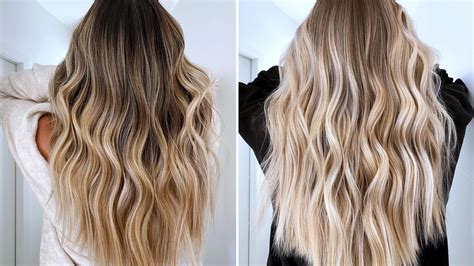Introduction
When it comes to hair coloring, balayage and highlights are two of the most popular techniques. Both methods can create beautiful, sun-kissed results, but there are some key differences between the two. In this article, we’ll take a closer look at balayage and highlights, so you can decide which technique is right for you.

What is Balayage?
Balayage is a French word that means “to sweep.” It is a freehand hair coloring technique that involves painting the hair with a brush or comb to create a soft, natural-looking gradient. Balayage is typically applied to the mid-lengths and ends of the hair, and it can be used to create a variety of looks, from subtle highlights to dramatic ombré effects.
What are Highlights?
Highlights are individual strands of hair that are lightened to create contrast and dimension. Highlights can be applied to any part of the hair, and they can be thin or thick, light or dark. Highlights are typically more noticeable than balayage, but they can also be more damaging to the hair.
Balayage vs. Highlights: Key Differences
Here is a table that summarizes the key differences between balayage and highlights:
| Feature | Balayage | Highlights |
|---|---|---|
| Application method | Freehand painting | Foiling or cap highlighting |
| Result | Soft, natural-looking gradient | Defined, individual strands of color |
| Damage | Less damaging | More damaging |
| Cost | Typically more expensive | Typically less expensive |
| Maintenance | Requires less frequent touch-ups | Requires more frequent touch-ups |
Which Technique is Right for You?
The best way to decide which hair coloring technique is right for you is to consult with a professional stylist. They can assess your hair type, desired results, and lifestyle to help you choose the best option.
Balayage: Pros and Cons
Pros:
- Creates a soft, natural-looking gradient
- Can be used to create a variety of looks
- Less damaging to the hair
Cons:
- Can be more expensive
- Requires less frequent touch-ups
Highlights: Pros and Cons
Pros:
- Creates defined, individual strands of color
- Can be applied to any part of the hair
- Typically less expensive
Cons:
- Can be more damaging to the hair
- Requires more frequent touch-ups
Common Mistakes to Avoid
Here are some common mistakes to avoid when getting balayage or highlights:
- Going too blonde too quickly. If you have dark hair, it’s important to lighten it gradually to avoid damage.
- Overlapping the highlights. This can create a harsh, unnatural look.
- Using too much bleach. Bleach can damage the hair, so it’s important to use it sparingly.
- Not conditioning the hair after coloring. Conditioning is essential for keeping the hair healthy and hydrated.
FAQs
Here are some frequently asked questions about balayage and highlights:
- Q: What is the difference between balayage and ombré?
- A: Balayage is a freehand hair coloring technique that creates a soft, natural-looking gradient. Ombré is a two-toned hair coloring technique that creates a more dramatic effect.
- Q: How long does balayage last?
- A: Balayage can last for up to 6 months, depending on how often you wash your hair and how quickly your hair grows.
- Q: How often should I get highlights?
- A: You should get highlights as often as you need to maintain your desired look. Most people get highlights every 6-8 weeks.
- Q: Can I do balayage or highlights at home?
- A: It’s not recommended to do balayage or highlights at home. These techniques require professional training and experience to achieve the best results.
Conclusion
Balayage and highlights are both beautiful hair coloring techniques that can create a variety of looks. The best way to decide which technique is right for you is to consult with a professional stylist.
